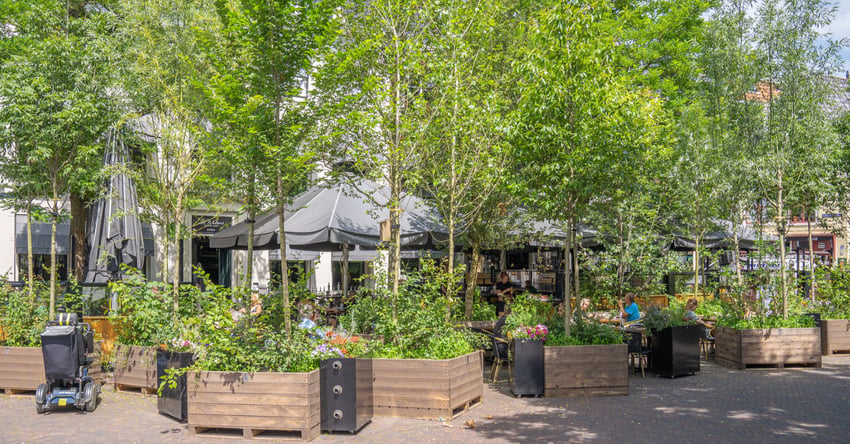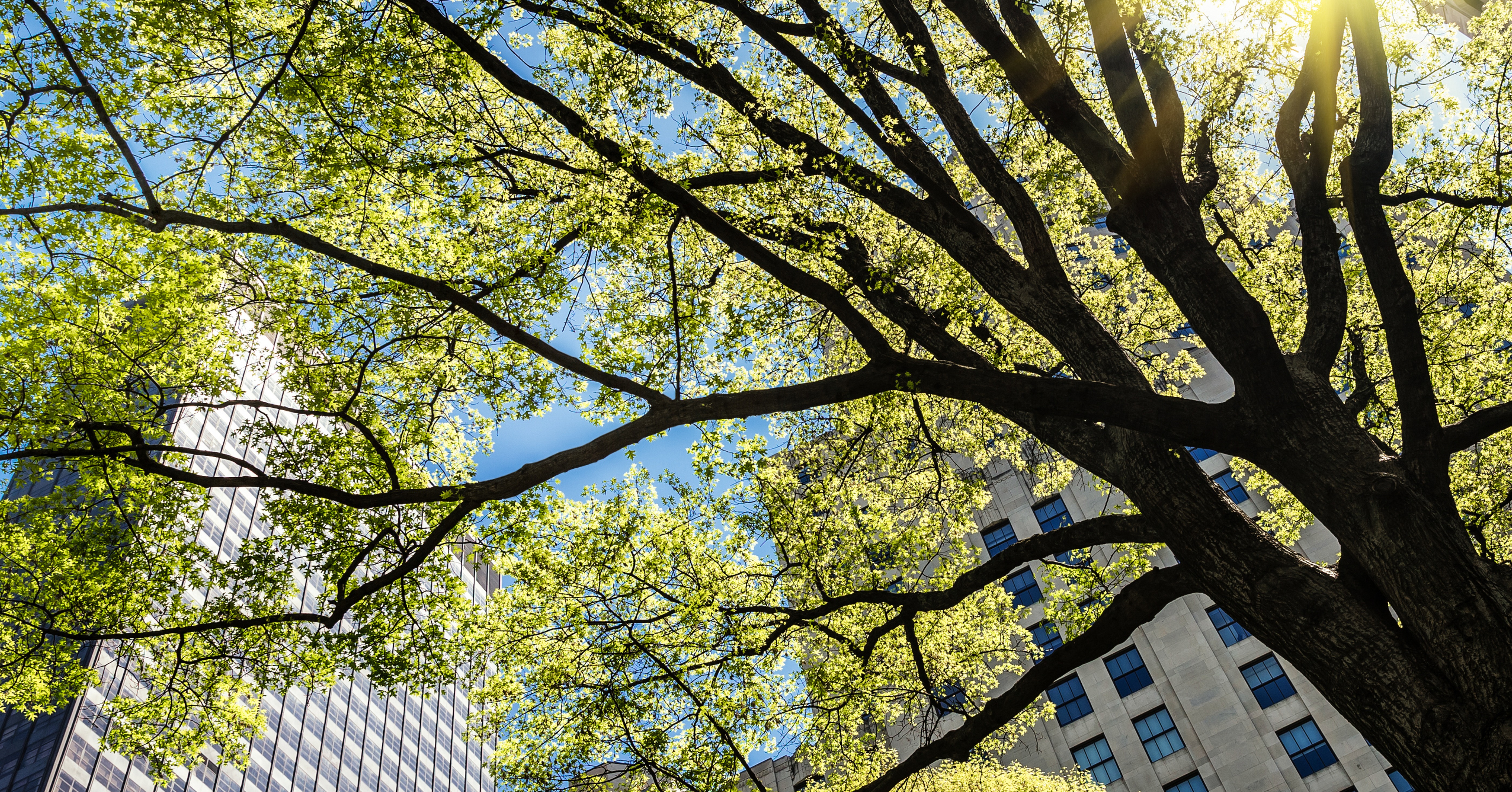The cooling capacity of trees

Trees lower the temperature of their environment. With a warming climate this is becoming increasingly important, certainly in urban areas. Thanks to their crown volume and leaf mass, trees provide shade to buildings and streets, allowing them to absorb and reflect less heat. They also expel water via a process we refer to as evapotranspiration. This term stands for evaporation of water from vegetation. This also cools the surrounding air. As a result, the temperature in areas in which trees are present may be up to six degrees Celsius lower than in adjacent treeless areas. In this article, we look at how the cooling effect of trees affects the city.
Heat island effect
Cities hold on to their heat for a long time, in particular via use of heat-absorbing materials such as brick, bitumen, asphalt and concrete. Cities cool down slowly because of this and this creates a heat island effect (Urban Heat Island (UHI) effect). The UHI effect refers to the phenomenon, whereby urban areas experience higher temperatures than surrounding rural areas. This effect has been observed for more than a century but did not gain scientific attention until the middle of the 20th century.
The first record of the UHI effect was described by Luke Howard in the renowned 1883 publication ‘The Climate of London’. Temperatures in cities were compared with those in surrounding rural areas. However, it was after the 1920s that the term “urban heat island” was used for the first time to describe this phenomenon. It was not until the 1970s that scientists began to study the UHI effect on public health and the city. They discovered that the UHI effect can result in a series of adverse effects, including higher energy consumption, higher air pollution levels and heat-related illnesses. This study contributed to awareness of the UHI effect.
Urban sustainability
In the ensuing decades researchers continued to study the UHI effect as well as possible solutions for reducing its effects. The proportion of high-rise buildings and the intensity of development play a key role. Following extensive research, amongst other ways, by comparing urban layout and planning, it appeared however that the presence of green space is crucial. City districts in particular where residents had a park at their disposal within a distance of 300 metres cooled down quickly. It also emerged that cities with many small parks cool down faster than cities with a few large parks. A good example is the Danish capital Copenhagen where there is a mix of large and small parks, with great scope for greenery along cycle paths and roads. Climate change means the chance for heatwaves has increased and these also are longer and more intense. This is on top of the general rise in temperature. These days, the UHI effect is recognised as a key barometer in terms of urban sustainability and adjustment to climate change.
How do trees cool the city?
Trees have a number of properties enabling them to cool down their environment. These properties are not equally strong in all trees. This is why it is a good idea to choose a varied range for planting. Only if a plant is in good condition will the properties function optimally and this applies to all plants; a tree with drought stress will have little to no cooling capacity. A few ways in which trees help to cool down cities:
- 1. Shade
Trees provide shade. The amount of sunlight reaching surfaces such as paving, buildings and vehicles is immediately reduced. This shadow effect can considerably lower the temperature in urban areas.
- 2. Evapotranspiration
Trees give off moisture via a process known as evapotranspiration and this cools down the surrounding air. This effect can be considerable in dry environments.
- 3. Airflow
Trees can influence the airflow and this can help to distribute heat and reduce the temperature. When air moves over the foliage of trees, it can become cooler. This cooler air can be transferred to the surrounding areas. In turn, this affects the evapotranspiration. This airflow is greatest along the leaf edge. Primarily trees with a composite leaf (Acacia-like) have relatively large leaf edges and so are heat-tolerant (Gleditsia, Robinia, Styphnolobium, Gymocladus and Albizia).
- 4. Reduced energy consumption
Trees can minimise light exposure on buildings. Because of their height, crown volume and mass they can cool buildings and reduce the energy required for artificial cooling (air conditioning). This has the effect of bringing down the temperature.
Which trees cool the most?
What the best tree species is to cool a city generally depends on a number of factors such as local (micro-)climate, soil characteristics and available space. A mix of different tree species is most effective. If a certain tree species is in trouble, then other species in the area will take over its function. Therefore, it is important to plant the right tree in the right place. Also, the amount of leaf mass and closed aspect of the crown determines the extent of shade effect. Suitable trees include:
Deciduous trees: these trees have large leaf surfaces which provide shade in the summer months during hot weather. In the winter months, the trees are bare and allow sunlight through. Examples being maple (Acer), oak (Quercus) and Zelkova (Zelkova).
Evergreen trees and trees that keep their leaves in the winter time: these trees provide shade all year round and protection from cold winds. Conifers in particular (Pinus) are ideal. Other options include non-deciduous oaks (Quercus x hispanica, ilex, suber) holly, (Ilex) and privet (Ligustrum).
Large crowned trees: these trees have large crowns that can provide a considerable amount of shade. Examples of such species widely used in cities are plane (Platanus), elm (Ulmus), lime (Tilia) and horse chestnut (Aesculus).
Trees with a high transpiration rate: trees with a high transpiration rate expel water to the air which contributes to lowering the temperature via evaporative cooling. Examples include notably pioneer species such as willows (Salix), poplars (Populus) and foxglove or empress tree (Paulownia).
How can you contribute to cooling in the city?
This can be easier than you think. Amongst other ways, the removal of as much paving as possible from your garden and planting greenery is a good step. Also installing greenery on roofs is a good way of aiding cooling. Remember to also use green walls. Planting climbers and training them over wires is a simple task which can make a big impact. A green city is a cool city.
It is obvious that trees are an essential part of a strategy for cooling cities. They also provide many other benefits, such as improved air quality, increased biodiversity and heightened aesthetic value.













